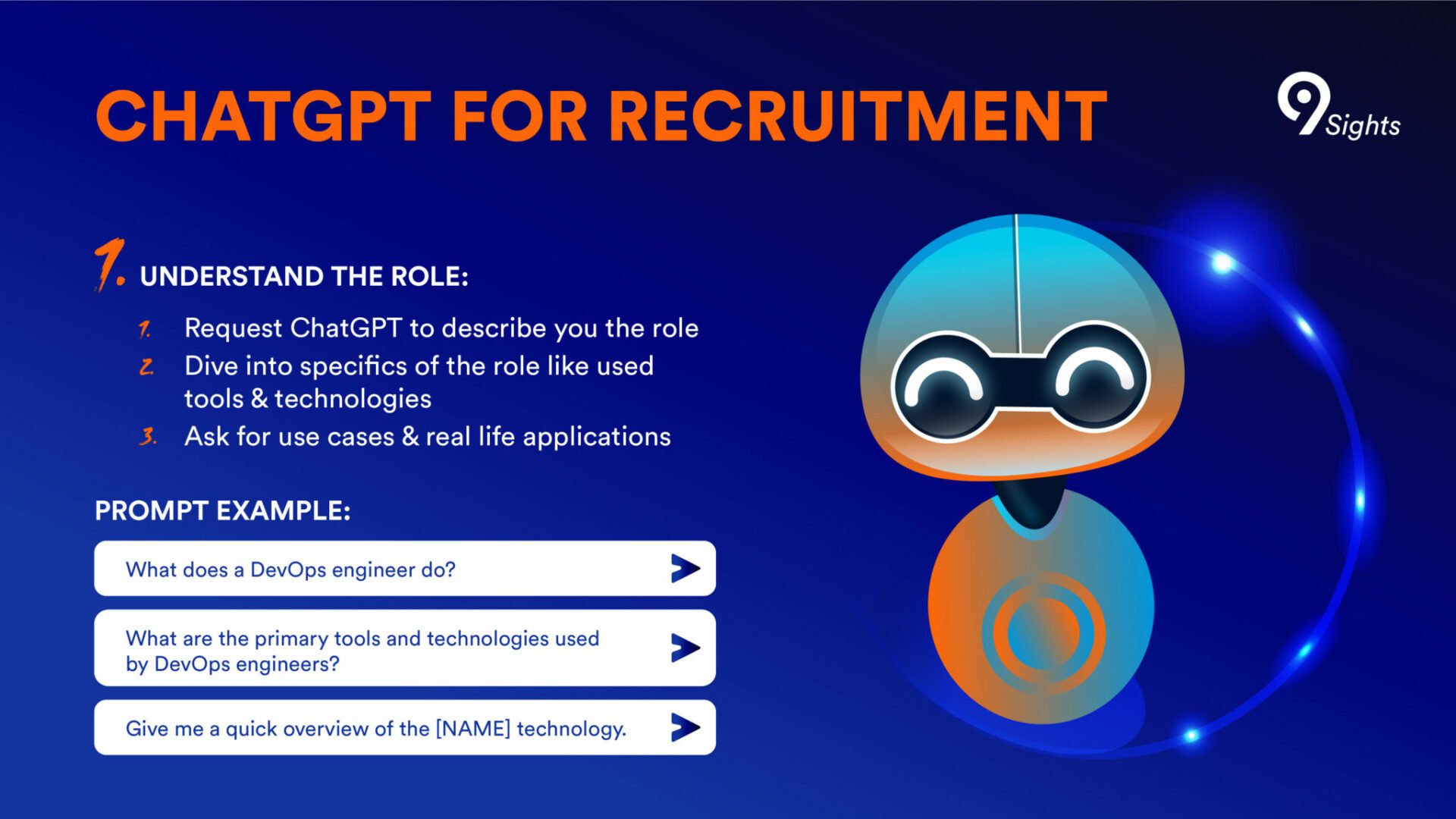Generative AI and GPT technologies are moving at a lightning pace. They first had an impact on fields like customer service, finance, marketing, and programming, but AI tools have recently made their way into human resources.
Complex platforms, such as Beamery TalentGPT, an AI-powered Applicant Tracking System (ATS) designed to manage recruitment processes, are beginning to emerge. Other powerful tools, such as Humantic AI, allow you to prospect candidates before interacting with them and learn more about their personality and work style. You can even use it to send messages that are tailored to their neuroscience profile. These sophisticated tools, however, are not the focus of this article. Instead, we’ll look at six quick and easy ways to use ChatGPT in recruitment without having to buy and customize an entire platform.

We will examine how to use ChatGPT in recruitment, highlighting its potential applications and providing examples to illustrate its effectiveness. We’ll go over how ChatGPT can be used to learn about roles and technologies (especially for junior recruiters), create job descriptions, craft engaging job posts, generate personalized messages for candidates, develop interview questions tailored to specific roles, and streamline the process of providing constructive feedback.

1. Upgrade your knowledge
One of ChatGPT’s main advantages is its ability to facilitate learning and research. This feature is particularly useful for junior IT recruiters, but it can also help experienced recruiters seeking to expand their knowledge of complex technologies or role-specific details. A recruiter, for example, can ask ChatGPT, “What does a DevOps engineer do?” and receive a brief description of the role and its responsibilities.
Recruiters can also use ChatGPT to stay current on technological trends in order to identify suitable candidates in the future. By asking questions like, “What are the primary tools and technologies used by DevOps engineers?” or “Could you give me a quick overview of the [NAME] technology?” recruiters can quickly acquire a comprehensive understanding of the role and the latest technologies involved.

2. Create the perfect job description
ChatGPT can simplify the process of creating job descriptions. Whether it’s a new role or an updated version of an existing one, ChatGPT can generate a well-structured job description in no time. For instance, if you need a job description for a Java Developer, simply input “Create a job description for a Java Backend Developer,” and ChatGPT will do the rest.
You can also tailor the request to your specific requirements and the seniority of the role. The job description of a Senior Developer will differ from that of a Junior Developer. Furthermore, you can customize the tone and length of the job description by requesting a shorter, longer, informal, humorous, or formal version based on your company’s culture and needs.

3. Post sparkling job announcements
ChatGPT shines on social media. For recruiters who may not possess creative flair, this tool is a true time-saver. Begin by asking it to create a job posting for you to share on LinkedIn or another recruitment platform.
Simply type in “Create a job posting for a Senior Python Developer to post on LinkedIn,” and the tool will generate it in seconds. Moreover, this request can be tailored to suit the recruiter’s unique style. Whether you prefer a concise and informal job post or a longer, more detailed one, ChatGPT can adapt to your preferences and create the perfect job post to match your recruiting approach.

4. Craft tailored DMs
Much like the previous example, ChatGPT can be used to generate customized messages for potential candidates during the recruitment process. While automating message delivery is a separate topic, it’s worth noting that ChatGPT can adapt to your specific recruitment style or the role you’re hiring for. For example, a junior position may necessitate a brief, informal message, whereas a senior position may necessitate a more formal tone and extensive job details. Just provide your requirements, and ChatGPT will generate the desired message in no time.
Here is an example of a message created by ChatGPT for a Senior Python Developer role:
Hey [Senior Python Developer]!
I hope you’re doing well. We’re looking for a talented Python developer to join our team for an exciting new project we’re working on.
The project involves developing a web application that will provide real-time analytics for a large-scale data processing pipeline. We’re using Python, Flask, and PostgreSQL, among other technologies, to build the application.
As a senior Python developer, we think you could bring a lot of value to the project. Your experience with software development methodologies, database technologies, and API integrations could really help us develop the most efficient and effective solutions for the project.
If you’re interested, let me know and we can discuss the details. We’d love to have you on board and see what you can do!
Cheers, [Your Name]
Of course, you can soften this message and make it more personal, depending on your style. It can be formal or casual, short or long. Maybe you want to be more to-the-point and provide all the details of the role in the message. You can use the structure provided by ChatGPT as a foundation to which you can add your human touch and any other information. Read along to find out why this is a good idea.

5. Prepare interviews in a snap
Fear not, ChatGPT will not be conducting candidate interviews any time soon. While it can perform various tasks related to interviews, such as pre-interview screening and answering candidate queries, these processes are a lot of work to set up. They also deprive the recruitment process of a personal touch.
However, ChatGPT can be used in many other ways to assist with interviews. For instance, if you’re recruiting for a new role that you’re unfamiliar with, such as a Scrum Master, the tool can help you gain a better understanding of the position and its requirements. It can also generate sets of interview questions that are specific to the role. You can, for example, ask the ChatGPT to “provide a list of questions to ask a Scrum Master during an HR interview.” This saves you time and effort, as well as the need to scour the Internet for information about the role and identify key aspects to explore during the interview.

6. Reject candidates gracefully
So what if the result of the interview is negative? Sure, everyone loves delivering good news, but some recruiters might have an issue writing a rejection. ChatGPT has no such feelings. As such, it’s a great resource to use for giving feedback.
For those who find it challenging to craft personalized feedback for rejected candidates, ChatGPT can be an invaluable resource. Ask the tool to generate feedback based on the specific reason for the candidate’s rejection. For example, “Create feedback for [NAME] developer who was rejected due to a lack of cloud and database knowledge.”
Let’s take a look at an actual output from ChatGPT:
Dear [Java Developer],
Thank you for taking the time to interview with our team. We appreciate your interest in the position and your enthusiasm for the work that we do.
After careful consideration, we have decided not to move forward with your application at this time. While we were impressed with your Java development skills and your experience in developing applications, we were looking for a candidate who also had knowledge and experience with cloud and database technologies.
As you may know, cloud and database technologies are becoming increasingly important in the development of modern applications, and we believe that these skills will be essential for success in this role. We encourage you to consider gaining experience and knowledge in these areas, as we believe this will help you in your future job search.
We appreciate your interest in our organization, and we wish you the best of luck in your future endeavors.
Sincerely,
The AI-generated feedback offers plenty of information about the reasons for the rejection and includes areas to focus on for future improvement. Just like in the previous example, you can customize the end result by adjusting its length, softness, or general tone to match your desired style.

The human touch
While ChatGPT is an incredibly powerful tool that can streamline many aspects of the recruitment process, keep in mind that it’s just that — a tool. Recruiters and others will soon be able to develop skills related to this tool. But the recruitment process cannot be void of the human touch.
Each candidate’s experience is unique and should be personalized based on the recruiter’s approach and the candidate’s individual needs.
One potential risk to consider when integrating ChatGPT into processes such as crafting job descriptions, providing feedback, and creating marketing materials is the potential for drifting into uniformity. Imagine if all companies used ChatGPT. As a result, their materials are more likely to be similar, making it difficult to maintain a distinct company identity.

Although the human touch should be maintained, AI tools can be useful at times. When it comes to saving time, it can make a huge difference for recruiters. It can help them better understand the technology, roles, and even the types of candidates they’ll meet during the interviews.
The human touch is the magic ingredient that sets each company apart. So, use ChatGPT in your recruitment processes, but be mindful of its downsides.










